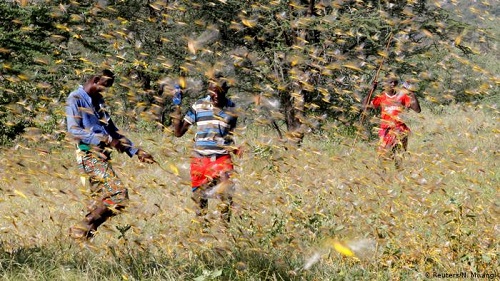
BY DARGIE KAHSAY
During the past two years, Eastern Africa particularly the Horn of African countries has been hit by Desert Locust swarm which affected crops, grazing lands and other vegetables. The huge invasion of the Desert Locust swarm in the region affected food security and livelihood problems as it seriously affected the productivity during the cropping seasons. According to Inter Governments Authority for Development (IGAD), second wave Desert Locust is currently active and threatening the region’s agro pastoral areas and IGAD warned member states to take preparation measures to control the second wave invasion of the desert locust.
The Intergovernmental Authority on Development Climate Prediction and Applications Centre (ICPAC) on Tuesday announced that Desert Locust creates a serious risk which may lead to significant impact on both crops and rangelands in Ethiopia, Sudan and Somalia. Current locust plagues are further exasperated by local economic and political limitations, which facilitate locust spread and place particular pressure on already vulnerable communities, ICPAC added.
The East Africa region has been grappling with swarms of desert locusts since 2019 and after reproducing itself rapidly and traveling long distance, the locust spread across the Horn of Africa in vast number which damaged crops, pasture and other vegetations in Djibouti, Eritrea, Ethiopia, Kenya, Somalia, South Sudan, Uganda and Tanzania, which was the worst desert locust upsurge in over 25 years in the region, IGAD stated on its recent statement.
Although desert locusts have been here since biblical times, recent intense outbreaks is linked to the rapidly intensifying climate change and the increased frequency of extreme weather events, ICPAC stated adding the warm, sandy and wet soil was the perfect environment for desert locusts to hatch from eggs, develop and breed during the past two years in the region.
Lack of preparedness, chronic political instability and limited capacity made the invasion the worst in a quarter of a century for most countries in the Horn region, and the worst in 70 years for Kenya, according to the information from IGAD.
According to the regional organization, very high desert locust threat creates a significant risk to both crops and other vegetables and green lands in Ethiopia, Sudan and Somalia due to the swarms recorded at the critical time of plantation of main season cereals crop. Ethiopia’s crops for the Meher season which is currently at its early growing stages is at risk due to the possibility of desert locust increase that follows high rainfall in July and forecasted in August, it added.
The heavy rainfall forecasted increases the likelihood of having abundant vegetation in those areas already having swarms, adult locust, bands and hoppers reported; ICPAC stated on its desert locust movement projection for August released this week. Ecological conditions, particularly the availability of green vegetation, continue to be suitable in parts of northern sub-region due to the current above average rainfall and this may continue to September, the regional organization forecasted.
IGAD Climate Prediction further indicated that to wind direction and speeds, which greatly determine swarm movement, are forecasted to be south-westerly which is likely to favor north-east and north-west locust movement for the mature swarms. Northern Ethiopia and Eritrea have wind direction forecasted to favor north locust swarm movement to Eritrea, Djibouti and across the Red Sea to Yemen and Saudi Arabia. Intermittent multi-directional winds may favor swarms to move in varying directions during the projection period, the center noted.
IGAD reported that during the month of July adult locusts have been reported mostly in north-western regions of Somalia and River Nile showing breeding and reproduction activities with a risk of increasing swarm numbers. The desert locust situation in Sudan during July is at the caution level particularly in the River Nile state.
Currently, IGAD statement disclosed, the desert locust swarms have been reported in 5 zones of Ethiopia, in 4 regions of Somalia and 2 regions of Djibouti. Considering the combination of wind movement, ecological conditions and forecasted weather indicators, IGAD indicated that a lot of zones and regions in Ethiopia, Eritrea, Djibouti, Somalia and Sudan are at high risk for swarm invasion. Especially, the continued high rainfall and the wet weather are creating favorable condition for the bread and expansion of the desert locust in the region, which needs strong preparations to control it.
Controlling such outbreaks requires a swift and coordinated response before it becomes a serious threat and beyond control, IGAD noted stated. Climatic changes due to increases in temperature, high rainfall and strong winds associated with tropical cyclones, provide a new favorable environment for locust breeding, development and migration.
According to IGAD’s weekly prediction heavy to very heavy rainfall is expected over parts of southern and central parts of Sudan, north-western Ethiopia, and Eritrea in the coming weeks. Warm and moderate temperature is also expected in most parts of these countries in the region. This may create suitable conditions for the breading and migration of the locust invasion which is currently available in few areas of the region.
Food and Agricultural Organization (FAO) in its August 05 statement announced that desert locust breading is underway in the summer breading areas in the Horn of Africa. According to FAO in recent weeks, mature swarms have been detected in northeast Ethiopia of Afar region, though few in number, while several swarms remain immature on the plateau in northwest Somalia.
According to FAO, the good rains falling in northeast Ethiopia and parts of southern Djibouti may create favorable breeding conditions for the desert locust in the Horn of Africa region and currently the controlling measures by the countries is low. FAO underlined that aerial and ground control operations should continue to control the mature swarms in the region. Similarly, it is necessary to prepare for eventual control operations against hopper bands that will form once hatching takes place later this month, especially in those areas where breeding could not be detected, it added.
To combat the desert locust invasion across the region and beyond IGAD is working with the member states and other international and regional organizations. On August 05, IGAD announced that it has signed a three million Dollars grant agreement with the World Bank for the formation of an inter-regional platform for the sustainable management of Desert Locust and other trans-boundary pests. The grant agreement is expected to run until August 2024, IGAD reiterated.
The overall goal of the Platform is to strengthen synergies, sustained management and control of desert locusts and other trans-boundary pests in the IGAD region, IGAD stated adding the platform will not limit itself to the IGAD members only, but to all countries affected by the desert locusts and other pests, according to the statement.
Operationalization of the Platform is planned to be conducted in partnership with the Desert Locust Control Organization for Eastern Africa (DLCO-EA) and the Commission for Controlling the Desert Locust in the Central Region (CRC) for the proper functioning of the new platform, the inter-regional organization announced.
The agreements mainly aim to support IGAD member states to strengthen their national preparedness plans for desert locust invasion, to develop a regional preparedness plan, to develop dissemination of knowledge management and communication, IGAD stated.
The Inter-Regional Platform is expected to provide an effective and well-coordinated early warning system and monitoring of desert locusts as well as ground and aerial control operations in order to detect hoper bands or adult swarms in time.
But, parallel to regional and international efforts to control the outbreaks of desert locust, each country should prepare to control and to manage the invasion as early as possible as the predictions are indicating the overall situation, the rapid climate change, the current ecological conditions, the continued heavy rainfall are creating suitable environment for the development of the desert locust swarm.
The Ethiopian Herald August 13/2021




